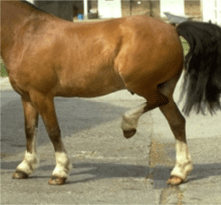Stringhalt is a gait abnormality characterized by exaggerated upward flexion of the hind-limb. It can affect one or both hindlimbs, with varying degrees of hyper-flexion. The exact cause is unknown, but degenerative lesions on long nerves of the hind limb have been identified in affected horses, resulting in the typical gait abnormality.
“Australian Stringhalt” has been classically associated with the ingestion of flatweed and dandelion. Other environmental factors, or the growth of fungus on these particular weeds, are suspected of being involved in causing the condition. Stringhalt often affects multiple horses in one region, and commonly occurs after a break in dry weather usually in late summer or autumn. Cases may also be “idiopathic”, where a cause is not identified.

Classical hyperflexion of the hock seen in stringhalt
Stringhalt diagnosis is often based on clinical signs on physical examination with a veterinarian. Stringhalt can vary significantly in severity and recovery. Some horses can recover spontaneously when taken off pasture and access to the weeds is removed. Mild cases may be intermittent, with gait abnormalities seen only in the first few steps. Most cases present with a consistent gait abnormality and difficulty backing-up.
Recovery from Stringhalt can be variable and difficult to predict. Some horses will recover spontaneously when taken away from the weeds. Other horses may take weeks, months or even years to return to a normal gait. Unfortunately, come cases of Stringhalt will become progressive conditions, with the gait abnormality becoming so severe that euthanasia may be warranted.
When stringhalt is suspected, moving the horse to a stable, clean yard, or a different paddock is always the first step. Supplementation with thiamine (Vitamin B1), Vitamin E and magnesium is recommended. In certain chronic cases surgical intervention may be considered.
Prevention is the best treatment. Please check your paddock regularly for weeds, or signs that your horse may be eating most of them.
If you suspect your horse being affected by stringhalt, please call Canberra Equine Hospital to book an appointment with an equine vet.
References: Veterinary Merk Manual, Plants Poisonous to Horses – An Australian Field Guide, Australian stringhalt by Dr. John Kohnke; Photos: © 2008 Zoya Akulova, Slichter 2009, wickimedia.org, vetstream.com;

